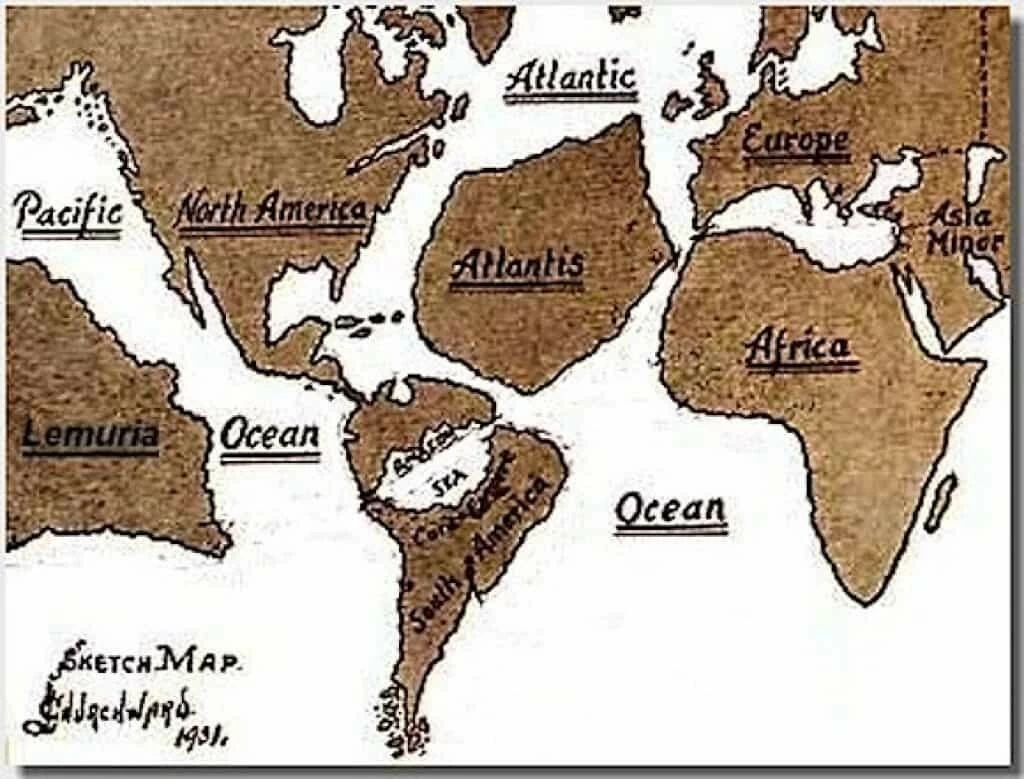Mu and Lemuria are so-called “lost continents.” Both were postulated in the 19th century and continue to have some believers to this day. The two lost continents differ in some ways and are very similar in others. In fact, some believers and even non-believers think they are the same. There is some evidence that Mu was a misinterpretation of stories of Lemuria, so this could be true. Like all lost continents, Mu and Lemuria are said to have been destroyed and sunk beneath the ocean. In the case of Lemuria, parts were said to have sunk while others remained. In the case of Mu, the continent was said to have sunk Atlantis-style in a day and night of catastrophe.

Map by James Churchward depicting Lemuria and Atlantis.
Lemuria
Lemuria is sometimes said to have existed in the Pacific, sometimes the Atlantic and sometimes the Indian Ocean. The very reason for this lost continent being theorized dictates that it existed in the Indian Ocean and possibly in both the Indian Ocean and the Atlantic Ocean. Therefore, all claims that it existed in the Pacific Ocean ignore the original premise and can likely be dismissed.
The idea of Lemuria came about when Philip Sclater could not reconcile that there were lemur fossils (in this case involving other primate fossils mistakenly categorized as lemur fossils as well as actual lemur fossils) existed on Madagascar and India but not along the logical route a land primate would take between the two, assuming Madagascar was a part of Africa. Sclater concluded that the two were once connected by a large continent. His theory spread and others found more supposed reasons why this must be true. The theory is still popular among occultists today. However, it was simply incorrect.
Sclater was looking for a mechanism to explain something he could not understand. Today, we know that the problem presented to him is solved by plate tectonics. A sunken continent would not have needed to act as a land bridge. The Earth’s plates move continents toward and away from each other, thus explaining why there are similar land animal remains in two areas of land separated by a body of water. Even if there were a land bridge of some sort that sank beneath the ocean, we would likely be able to see it with advanced mapping techniques used today to map the ocean floor. There is nothing there.
Mu
Mu differs from Lemuria in that it was based on assumptions that had naught to do with science. On first glance and even upon closer observation, it looks like Mu was completely fabricated based on a description of Lemuria and later some alleged artifacts and translations that sound dubious at best. Mu was initially postulated by Augustus Le Plongeon. While his claims were tame compared to later claims about Mu, he did say that Mu sank overnight and that humans who fled the sinking continent established both the Mayan and the Egyptian ancient civilizations. Writer James Churchward took that thinking to an entirely new level.
Augustus based his claims on supposed translation of Mayan text, saying a woman called “Queen Moo” left Mu and established ancient Egyptian civilization. There is no evidence of this apart from his word, which brings us to James Churchward. Churchward went a little crazy in his claims. He said that he went to India in his youth and met a priest who showed him ancient clay tablets. He mastered the language on these tablets, which he called “Naga-Maya.” Having learned the language, he read the tablets, which spoke of the land of Mu. He also claimed that he translated the Niven Tablets, which he also said spoke of Mu.
There are multiple holes in Churchward’s story. Firstly, no one else has ever seen these alleged tablets. Secondly, he says he was a soldier in India when he saw them. That does not make him an expert in translating ancient texts. Thirdly, when he wrote of the texts, he had not seen them in more than fifty years or so he says. He never showed anyone his translations or the text on the tablets. Did he commit them to memory? Then comes the Niven Tablets. They were never translated by anyone and they are now lost so there is no way to translate them now. The whole thing reeks of an author trying to sell books and that is what it is generally regarded as. Why? Because science does not support the story in the slightest.
We know that islands and small pieces of continents have gone under the ocean. This process takes time and is observable with modern tools. Continents can break apart and shift around but even that takes millions of years. Catastrophes like volcanic eruptions, earthquakes, tidal waves and hurricanes slam the Earth’s continents every year and not even one has just vanished during man’s occupation of the Earth. One must take into account the sheer size of a continent. Atlantis was an island, which makes it far more probable than Mu or Lemuria. It would not only be hard to sink a continent, it would be very difficult for it to hide from us today. Understanding of plate tectonics and the positions of the continents in relation to each other have ruled out the existence of a huge continent smack in-between them.
Sources
Mu, retrieved 2/10/12, badarchaeology.com/